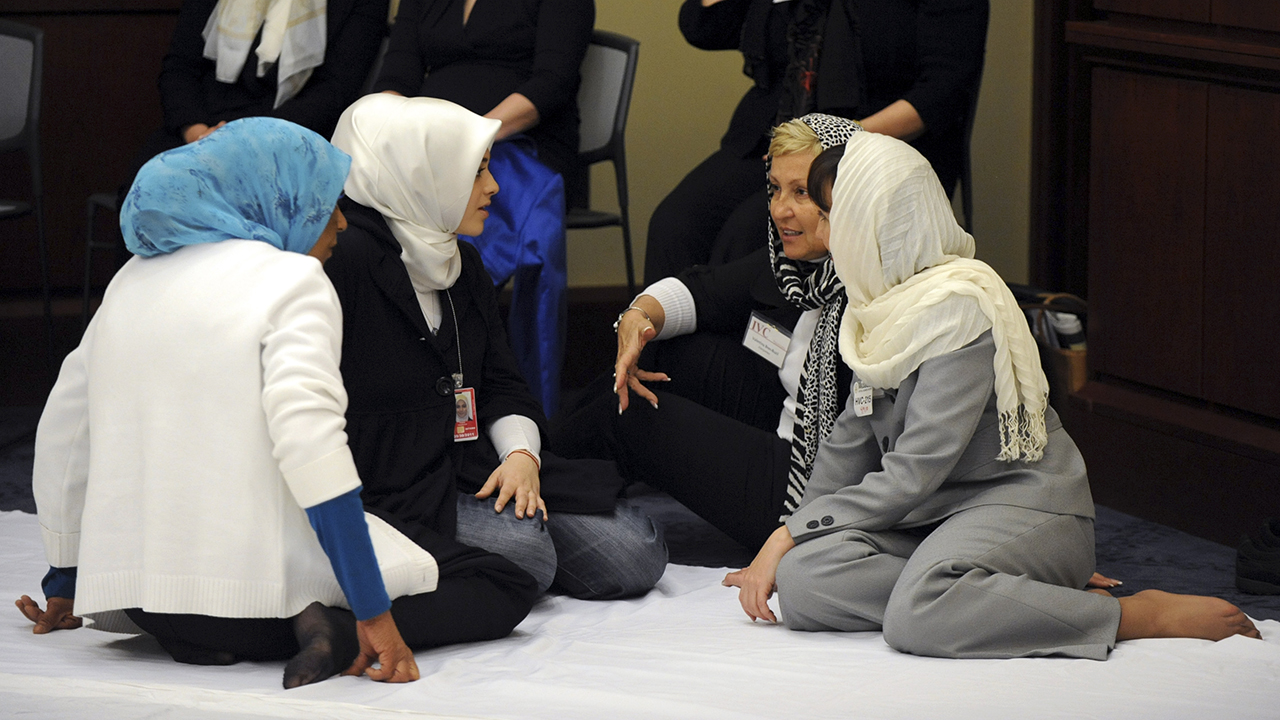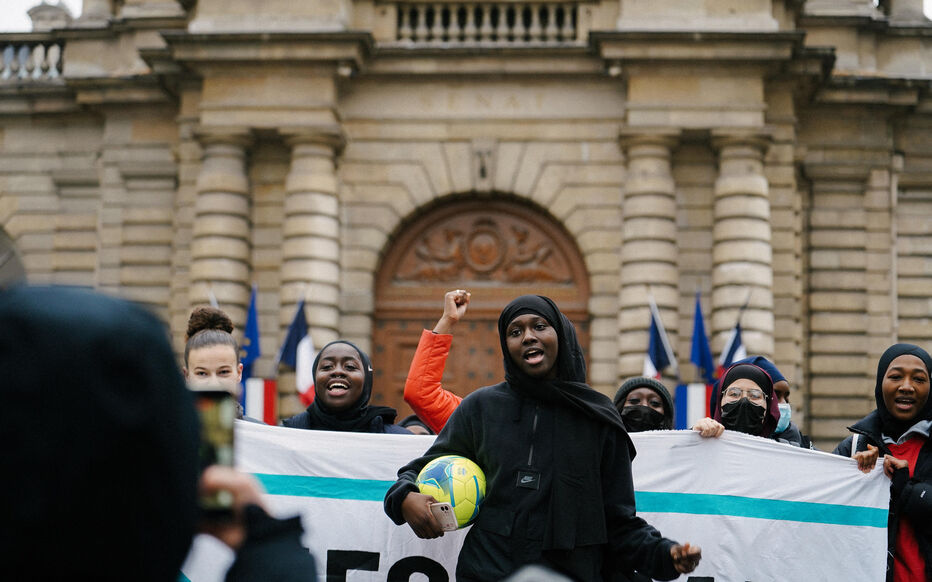March 27th 2022 saw the celebration of Muslim Women’s Day. Launched in 2017 by MuslimGirl.com (an online platform that enables young Muslim Women to share their stories of what it means to grow up in the U.S.), the founder, Amani Al-Khatahtbeh stated Muslim Women’s Day is:
“a call to action to … centre Muslim women’s voices for the day, to empower us, to flood the internet with new, diverse, positive stories and Muslim women’s voices”1.
In line with this call to action, The Institute for Social Policy and Understanding (ISPU) sought to highlight some of the key information on women’s experiences in Muslim Spaces. The data comes from the second report from the US Mosque Survey 2020 (released in July 2021). Authored by Dr Ihsan Bagby of the ISPU, Report 2: “Perspectives and Activities”, focuses on women in the mosque, as well as Islamic approaches in understanding Islam, perspectives of mosque leaders on American society, mosque activities, and the perspectives and activities of Shi’ite mosques2. According to Dr Bagby:
“The position and role of women in the American mosque is one of the most contentious issues within the America Muslim community. The inherited culture from some countries and some interpretations of the inherited intellectual tradition are that women have a limited place in the mosque. The American Muslim community in general never accepted the idea that women should be excluded from the mosque, but many mosques never embraced the active involvement of women.”3.
There was a hope that the 2020 US Mosque Survey would show progress in regards to women in the U.S. mosque. The results of the survey however, are mixed: there has been some progress, but little change4.
(See Euro-Islam “US Mosque Study 2020: Key Findings” for more information on part one of the study.)
Background and Methodology
The US Mosque Survey 2020 is a statistical study of mosques in the U.S. that aims to provide a detailed and accurate account of the “American Mosque”. In doing so, its primary goal is to dispel misconceptions and help mosque leaders and participants better understand their mosque, which will hopefully lead to improvements within them5.
For the US Mosque Survey, mosques were identified as Sunni or Shi’ite Muslim organisations if they organised Jum’ah prayer, conducted other Islamic activities, and controlled the space within which these activities were held. The ISPU notes that this definition would include “musallas” which have an organisation that does more than solely conduct Jum’ah prayers, but would exclude places were only Jum’ah prayer is held. This would include locations such as hospitals and airports6. They also include some Shi’ite organisations as mosques that do not hold Jum’ah prayer due to the absence of a resident scholar or because they consider themselves an Imambargah or Hussainiya7. Also excluded from the Mosque survey were organisations such as the Nation of Islam, Moorish Science Temple, Ismailis, and Ahmadiyyah.
There were two phases to data collection in the mosque survey, which was conducted prior to the outbreak of Covid-19. Stage one took place from June to November 2019 and, starting from the 2010 mosque database, an initial search was conducted to verify mosques, eliminate those that no longer existed, and identify any new mosques. This search resulted in an initial count of 2,948 mosques8. Mosques were verified via their websites, Google Maps, and a phone call. A first-class letter and short questionnaire were then sent to all verified mosques. Of the 2,948 mailings, only 164 responses were received, a low 5.5% response rate9.
Phase two was a more comprehensive survey, which was conduced via telephone interview with a mosque leader, using a longer questionnaire from November 2019 – October 2020. This more comprehensive survey entailed a random sampling from the list of mosques. The sample was stratified by state, whereby each state had a set number of mosques for which the questionnaire had to be completed10. 700 mosques were randomly sampled, and 470 questionnaires were completed.
Results on Woman and The Mosque
- Use of Divider in the Mosque
The central debate about women in mosques is the issue of whether women should pray in the same space as men, in a separate room, or behind some form of divider11. Within the report, the ISPU categorises mosques as not having a divider if they offered the choice for women to pray behind a barrier, or within the same prayer space as men. Mosques that had a mezzanine area for women (5% of mosques in the survey), were coded as having a divider. Mezzanines were purposefully installed in mosques as a compromise to give women the ability to see the Imam below.
When answering the question “For the daily salah, do women make salah behind a curtain or partition or in another room?” the results show that 65% (almost two-thirds) of mosques still have a divider, with 34% not having one. This figure has remained steady since the 2010, and 2000 survey, where 66% of mosques in these surveys had a divider12. The survey does not differentiate between responses given by men or women.
When breaking these statistics down further, the survey shows that African American mosques have the highest percentage of mosques with no divider. 66% of African American mosques do not use a divider compared to 31% of immigrant mosques. According to the ISPU this difference in the use of dividers is due to the influence from traditions where women are often marginalised that have influenced the mindset and practice of Muslims who have immigrated to America13.
Similar statistics are found when looking at the nationality of the mosque leader. Full-time paid imams who are American born are, according to ISPU research, much more likely to lead mosques with no divider. 50% are reported as not having a divider compared to 31% of mosques with full-time imams being born outside the U.S.14. The ISPU refers to this as the “effect of the American experience vs. cultural heritage from overseas”15.
Another correlation in this trend is with community and political involvement where mosques that are actively involved in their local communities and have higher levels of political involvement are more likely to have no divider in the mosque for women. As shown in Figure 17 below, 54% of mosques considered to have high involvement in politics and their community do not have a divider, compared to 22% of mosques that have a low involvement.
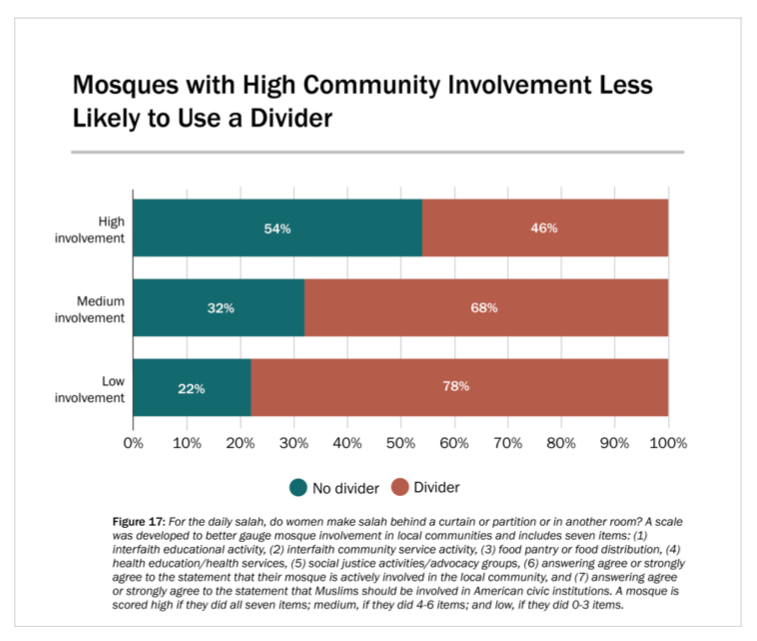
A final variable associated in the divider debate is the Islamic approaches the mosque takes. As shown in figure 18 below, 83% of mosques that have a more traditional approach to teachings and 76% of mosques that follow madhhab have a divider in their mosques. This is significantly higher than mosques that follow a more contextual approach where 51% still have a divider, which is still considered statistically high16. By “Contextual approach”, the report is referring to interpretations that take into account the purposes of Islamic law (the spirit and wisdom of the law) rather than adhesion to a particular school of jurisprudence (or Madhab) 17.
The ISPU reference the intellectual heritage of traditional scholars and madhhabs followed for being the reason for the high percentage of mosques having a divider, due to their prohibition of women’s presence in the mosque or in leadership roles18. Whether or not a mosque has a divider is not connected to budget, location, mosque size, or high scores in mission, identity and vitality19.
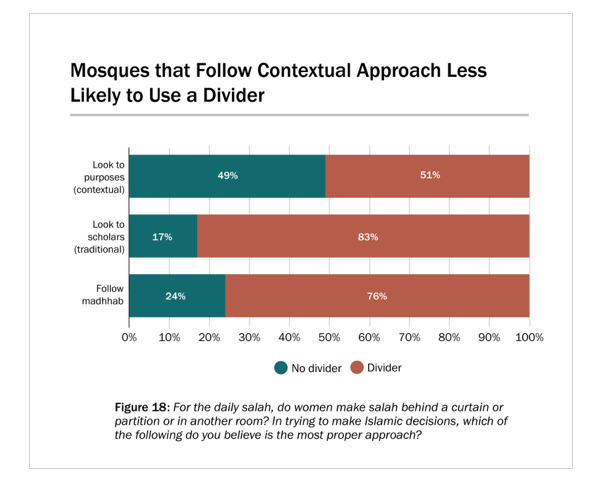
2. Women’s Participation on Mosque Boards.
Despite there being no improvement on debate around the use of dividers for women in the mosque, there has been a significant increase of mosques with women on their boards. Over two-thirds of mosques (67%) have women serving on their mosque board, which is an 8% increase from 2010, and 17% increase since 2000.
When breaking these statistics down further, the survey shows that African American mosques have a higher percentage of women on their boards, with 83% of mosques having women serve on their boards, a further 9% of mosques allowing women, but with none currently serving, and 7% not allowing women20.
Also, mosques that follow a contextual approach are more likely to have women serve on their board, with 79% of these mosques having women serve, 18% allowing women, but with none currently serving, and only 3% not allowed21. Mosques that look to traditional scholars have the lowest amount of women serving on their boards (47%) but a further 43% are allowed, but have none serving. Over half of mosques which follow madhhab have women serving on the board (59%), a higher percentage than those who follow traditional scholars. However, 18% of mosques that follow madhhab still do not allow women on their boards.
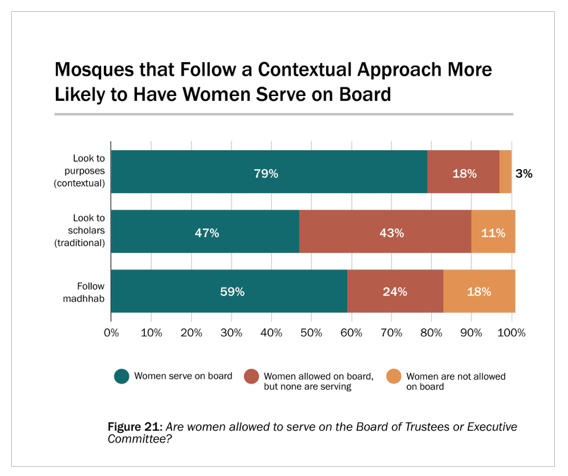
The final variable of political and community involvement shows that having higher involvement is associated with having women serve on mosque boards. 87% of Mosques that have a high political and community involvement have women serving on their boards, with only 1% not allowed22. This is 28% higher than mosques that have a “medium involvement” and a 51% increase from mosques that have “low involvement”
3. Women’s Attendance at Jum’ah Prayer
The percentage of women attending Jum’ah prayer had not changed significantly since the 2010 mosque survey, increasing to only 1% to 19% of women attending in the last decade. The ISPU give two reasons for this low percentage. Firstly, mosques have not changing significantly to make Jum’ah attendance more attractive to women. Secondly, the majority of Muslim Women are first-generation immigrants who still carry traditional culture and religious perspectives of women not attending Jum’ah23.
African American Mosques have a higher percentage of women attendees at Jum’ah, with 23% of their attendance comprising of women, 5% higher than Immigrant mosques24.
The attendance of women at Jum’ah prayer is also impacted by the mosque’s Islamic approach. Mosques that follow a more flexible approach of looking at context and purposes of the law have a higher attendance of women attendees at mosque. 21% of attendees at mosques following the purpose of law are women, compared to 16% being women at mosques follow traditional past scholars, and 15% that follow a madhhab25.
Higher female attendance is also associated with mosques that have higher community and political involvement, where women make up 21% of their Jum’ah attendance, compared to 19% who have medium community and political involvement, and 14% in mosques that have low involvement26.
The ISPU also recognise the size of an immigrant mosque to be a factor affecting women’s attendance. Larger immigrant mosques see a larger attendance of women at 20%, compared to smaller mosques only having 14% in attendance. According to the ISPU this is because larger mosques are better at accommodating women by giving them more space27.
A final factor concerning the attendance of women at Jum’ah is the number of mosques that have women on their boards. Mosques that have women on their boards have a higher percentage of women attending Jum’ah (21%). This is an 8% higher attendance for women, than at mosques without women on their boards28.
4. Women’s Programs in the Mosque
77% of mosques have women’s activities and 55% have a women’s group29. Factors impacting whether or not a mosque has women’s activities and/or groups is the size of the mosque, where larger mosques increase the likelihood of women’s groups and activities being held. Immigrant mosques tend to have more women’s groups and activities. This is because African American mosques tend to be smaller (63% of African American Mosques have 100 or less in Jum’ah attendance), and women are better integrated in all activities in African American Mosques30.
The Islamic approach of a mosque does not impact whether or not a mosque has women based activities or groups.
5. The Women-Friendly Mosque
Scores for women-friendly mosques improved from 2010 to 2020. This scale was devised for the 2010 survey and then repeated in 2020. The scale for the survey consists of four indicators: (1) no dividers in the mosque; (2) women serve on the mosque board; (3) women’s attendance at Jum’ah averages about 19%; (4) women’s activities and/or a women’s group are present. To score excellent, a mosque must have all four indicators, three for good, one or two to score fair, and poor if the mosque scored none31.
In the 2020 survey, 19% of mosques scored excellently compared to 14% in 2010 (a 5% increase) and 30% of mosques scored well (or good) in comparison to 23% in 2010. However, the majority of mosques (52%) still score fair or poor. Also, according to the ISPU only 19% of mosques can be truly designated as women-friendly mosques, which is a low percentage32.
Factors affecting the women-friendly score for mosques are being an African American mosque, high community and political involvement, Islamic approaches in teaching, and Imam nationality. When looking at the statistics for each factor, 34% (almost one-third) of African American mosques scored as excellent compared to 16% of immigrant mosques33. 39% of Mosques with higher political and community involvement score excellent in being women-friendly mosques, 29% of mosques that follow the flexible approach of looking to the purposes of the texts are much more likely to be women-friendly. This is 21% higher than mosques scoring excellent that follow scholars of the past, and a further 23% higher than mosques that follow a madhhab34.
Finally 32% of mosques that have a full-time, paid American born imam score excellent in the women-friendly scale as opposed to 18% of mosques with a full-time Imam not born in the U.S35.
References
- https://edition.cnn.com/2018/03/26/middleeast/muslim-girl-amani-al-khatahtbeh/index.html
- https://www.euro-islam.info/2021/06/25/us-mosque-study-2020-key-findings/
- https://www.ispu.org/report-2-mosque-survey-2020/
- https://www.ispu.org/muslim-womens-day/

